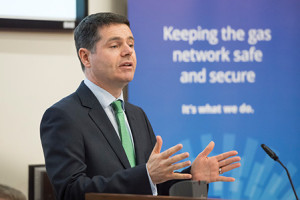Transport’s paradigm shift
 Recovery is creating new challenges on our roads and railways, Minister for Transport Paschal Donohoe told Transport Ireland 2015. He will be pushing for extra funding to make sure that the system meets its maintenance requirements and has the potential to expand.
Recovery is creating new challenges on our roads and railways, Minister for Transport Paschal Donohoe told Transport Ireland 2015. He will be pushing for extra funding to make sure that the system meets its maintenance requirements and has the potential to expand.
Paschal Donohoe has announced that he will be seeking a “substantially larger” budget for transport to meet the new demands on Ireland’s roads and railways. “Given the improved economic situation and the level of demand on our land transport network, I will be making a strong case for additional funding,” the Minister for Transport stated in his address to the annual Transport Ireland conference.
He explained that the economic recovery presented opportunities and challenges in the transport sector. The downturn reduced demand and constrained funding but the context has “changed very rapidly” in recent months.
“Transport and the performance of the wider economy are naturally linked,” he commented. “An efficient and fit-for-purpose transport system facilitates and supports economic growth. It provides the crucial link between communities and workplaces, between regions and towns and, of course, between Ireland and international markets.”
National economic performance largely determines the level of transport demand with each new job increasing the number of commuters, each extra tourist needing adequate options to travel around the State, and increased trade demanding better freight links.
Donohoe anticipated that the Irish economy will expand by 4 per cent this year, on the back of 5 per cent growth last year. Unemployment has fallen significantly. Ireland attracted an additional 600,000 visitors in 2014 “and we’re going to see another great year in 2015.”
Congestion
The Minister, though, recalled the significant obstacles which unsustainable growth caused in the years before the crash. High quality motorways, ports and airports were put in place but some of those growth-related challenges are emerging again. Traffic congestion is a “growing and acute problem” in major urban areas with hotspots causing delays in journey times.
“Anyone using the M50, as I did early this morning, will be very, very conscious of this,” Donohoe remarked. “Indeed, traffic levels between Junction 6 and Junction 7 are now 35 per cent higher than when the toll barriers were removed in 2008.”
The absence of traffic was “one of the starkest indicators of our economic collapse” and its return was “welcomed by many for a period of time.” The Minister is now very much aware that this period of welcome is “now rapidly turning to a feeling of frustration” for many people.
Public transport growth is an important driver of demand and 2014 saw the following year-on-year increases in passenger numbers:
• 1 million on Bus Éireann;
• 1.1 million on Irish Rail; and
• 2.1 million on Luas;
• 3.8 million on Dublin Bus; and
• 8 million on bus, train and light rail combined.
These are “extremely welcome” developments but appropriate infrastructure and public service obligation (PSO) funding are needed.
“For the first time since 2008, the level of PSO contribution for bus and rail services is being maintained in 2015 at the same level as the previous year,” he stated. “I also secured €110 million for public transport as part of the supplementary estimate for my department, which included €45 million for Irish Rail network renewal investment and €50 million for bus renewal.”
Donohoe also pointed to the significant progress in constructing Luas Cross City and the plans to implement bus rapid transit in Dublin.

He stated on record that he is “fully aware that it won’t be enough just to maintain PSO funding levels if we are to deal with the challenges of increased demand.” Improved public transport will require additional funding and the commuter “cannot be expected to pay for all of this.”
The Government will continue to seek efficiency improvements but he acknowledged that “very significant efficiencies” have already been delivered in public transport companies in response to seven years of funding cuts. The Minister and his department would seek to secure an increase in PSO subvention “so that additional services can be provided where the levels of need and the pressure areas are greatest.”
Support for improved bus services should be accompanied by “an appropriate degree of competitive tension within the market, in the interests of quality and cost-effectiveness for commuters.” The National Transport Authority (NTA) has now initiated the tender process and discussions with employees are continuing at the Labour Relations Commission.
Motorway development has brought “huge benefits” for inter-urban bus commuters but with a trade-off for the level of service at some stops between those cities. Inter-urban services operate in a competitive market without PSO subvention. The Minister publicly acknowledged the NTA’s recent work in reconfiguring services to deal with this challenge.
The shift towards sustainable transport was “placed in sharper focus by a growing economy”. Transport makes up a third of Ireland’s primary energy demand and transforming the usage of energy would require imaginative and new thinking.
Compressed natural gas could benefit the environment but he also saw merit in car sharing schemes, and supported the roll-out of electric vehicle charging infrastructure and Dublin Bikes – now replicated in Cork, Galway and Limerick. “We must continue our efforts to ensure that the growth in transport demand is as sustainable as possible,” he stated.
Planning
Public finances dictate that funding for transport “will be constrained for years to come” hence the need for smart decision-making. The Strategic Framework for Investment in Land Transport will shortly be presented to the Government. This will provide an evidence base for prioritising funding and compare current levels of investment spending against Ireland’s historic average, its international competitors, and the estimated minimum funding requirement.
Annual investment in land transport historically averaged at 1.1 per cent of GDP and rose to 1.4 per cent between 1999 and 2011. The figure fell to 0.7 per cent in the following year and has undoubtedly fallen further since then.
“At this moment, we are investing in our system at a level well below what we normally do despite the increased pressures that we are encountering,” Donohoe confirmed. The preparatory work for the framework estimated the ‘steady state’ cost of maintaining the transport system as being €1.3 billion per annum.
Total Exchequer spend in land transport will amount to around €1 billion in 2015 i.e. leaving a €300 million gap “to just keep things as they are”. Evidence-based decision making, creativity, innovation and further efficiency is needed more than ever and difficult choices “will continue to be made and continue to be implemented by all stakeholders in the transport sector.”
The framework recommends the development of a new rail policy which will involve a public consultation process in the coming months.
“We need to communicate clearly to the broader public where rail’s greatest strengths lie and where rail is perhaps less effective as compared to, for example, bus services,” he contended. “We also need to communicate the extent of investment required for the rail network.”
Investment
The new capital investment plan for land transport will be finalised before the summer. Funding allocated for land transport under the current capital plan (up to 2016) has mostly been used to protect existing road and rail assets and maintain safety standards. This level of funding, if maintained over the medium term, will be “insufficient to adequately meet required standards and will lead to more costly renewal at a later stage.”

Some funding has been set aside for essential projects which have a sound business case and add value to the existing network (e.g. Luas Cross City) or develop smart technology (e.g. real-time passenger information). He paid a strong tribute to the residents and commercial stakeholders in Dublin who are helping to ensure that the Luas works take place. The Government’s PPP infrastructure stimulus programme is now coming to fruition with two projects under construction and another two at an advanced stage in the procurement process. The NTA’s review report into the Fingal-North Dublin corridor will be considered alongside an updated business case for the DART Underground project and a draft transport strategy for the Greater Dublin area.
“If any major project is prioritised then the cost and availability of funding will be a key determinant of timing and delivery,” he added. “I would hope to include funding to progress at least the planning and design in our capital plan.” Any additional funds in the immediate term will be used to improve bus services, including the development of bus rapid transit.
Donohoe is also committing funds to open the Phoenix Park tunnel in 2016, bring some scheduled passenger services on the Kildare Line to Connolly Station, improve the DART service, build more and improve existing cycle lanes, and continue with smart technological upgrades.
Any additional investment for roads will focus on bottlenecks and safety, improving access to major ports and airports, and meeting the needs of industry. It will also be linked to public transport investment (where required) as to ensure “seamless” transfers between different modes of travel.
“The analysis and work we are undertaking in these areas is an example of how key strategic transport policy is evolving,” Donohoe remarked. “It’s truly a great privilege and it’s a responsibility I’m humbled by, every day, to be in this role at such an exciting time because the paradigm has shifted from dealing with economic decline to supporting growth.”
The Minister concluded: “It is imperative that the decisions we take today, to enhance transport’s role in this country’s development, continue to be smart and that they continue to be evidenced-based. Alongside that, it is clearer to me than ever that there is a strong case for more well-targeted investment in our transport system. This investment is critical to keep our country moving.”





